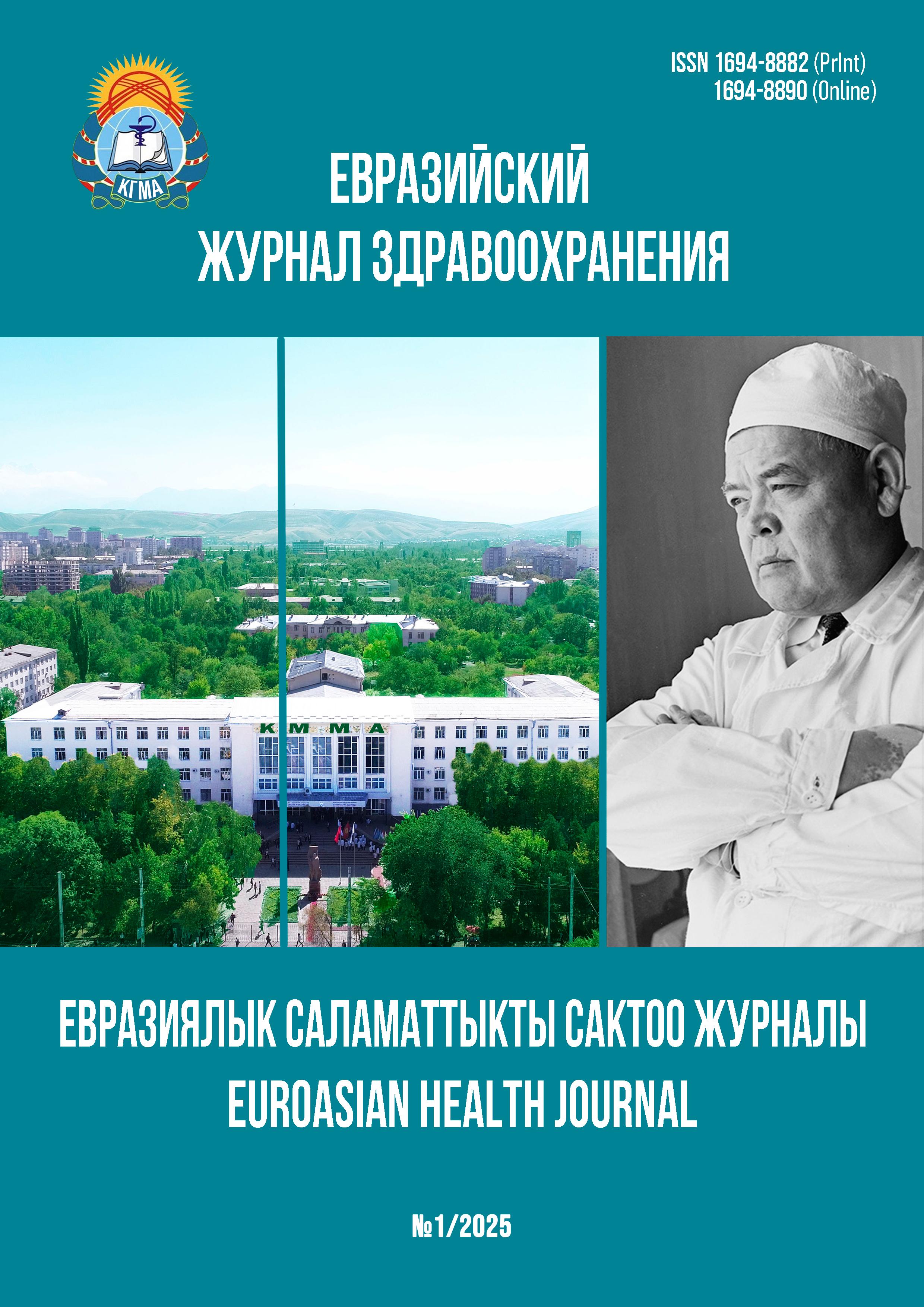ETIOLOGICAL AND CLINICAL-EPIDEMIOLOGICAL ASPECTS OF MYCOSES OF THE FEET AND ONYCHOMYCOSIS IN OUTPATIENTS
DOI:
https://doi.org/10.54890/1694-8882-2025-1-65Abstract
The etiological and clinical-epidemiological features of foot mycoses and onychomycosis in outpatients were studied. In total, there were 326 patients with onychomycosis and mycosis of the feet treated in the clinic of the RCDV and the Family medicine centersin Bishkek. There were 140 men (42.9%), women – 186 (57.1%). KOH microscopy and culture studies on highly selective Sabouraud media were used for diagnosis. Mycosis of the feet and onychomycosis in almost all cases are caused by dermatomycetes - Tr. rubrum and Tr. mentagrophytes var. interdigitale (93.6%). Tr. rubrum as a monoinfection prevailed 7.8 times over Tr. mentagrophytes var. interdigitale (75.3% vs. 9.7%); combined lesion of Tr. rubrum with mold fungi was registered in 5.3%, with fungi of the genus Candida in 3.1%. Mixed infection Tr. mentagrophytes var. interdigitale + molds in 1.8%. Mold onychomycosis in the form of a monoinfection – in 3.5%, candidiasis of the nails – in 1.3% of patients. Women outnumbered men by 1.3 times (57% and 43%, respectively). Onychomycosis was 1.6 times more common among employees compared to pensioners (43% versus 27.6%). Concomitant diseases were common (66.3%), with the predominant pathology of the gastrointestinal tract and cardiovascular system, angiopathy of various origins. The distal-lateral form of onychomycosis was registered in 53.9%, total-dystrophic – in 31.9% of patients. Skin lesions on the feet were noted in all patients with onychomycosis, with squamous (48.2%), squamous- hyperkeratotic (21.2%) and hidden (14.4%) forms of mycosis prevailing.
Keywords:
onychomycosis, mycosis of the feet, epidemiology, etiology, outpatients, concomitant diseasesReferences
1. Позднякова О.Н., Чебыкин Д.В., Бычков С.Г. Современные особенности эпидемиологии зооантропофильных дерматомикозов, микозов стоп и кистей, онихомикозов в Новосибирске. Journal of Siberian Medical Sciences. 2019;2:71-78. https://doi.org/10.31549/2542-1174-2019-2-71-78
2. Усубалиев М.Б. Лечение осложненных форм микозов стоп. Вестник КГМА им. И.К. Ахунбаева. 2020;5-6:18-22.
3. Яковлев А.Б. Системная терапия онихомикозов стоп тербинафином: динамика санации ногтей и качества жизни (многоцентровое наблюдательное исследование). Российский журнал кожных и венерических болезней. 2021;24(2):167–178.
4. Gupta A.K., Stec N., Summerbell R.C. Shear NH, Piguet V, Tosti A, et al. Onychomycosis: a review. J Eur Acad Dermatol Venereol. 2020;34(9):1972–1990. https://doi.org/10.1111/jdv.16394
5. Nussipov Y, Markabayeva A, Gianfaldoni S, Tchernev G, Wollina U, Lotti J, et al. Clinical and Epidemiological Features of Dermatophyte Infections in Almaty, Kazakhstan. Open Access Maced J Med Sci. 2017;5(4):409-413. https://doi.org/10.3889/ oamjms.2017.124
6. Соколова Т.В., Малярчук А.П., Малярчук Т.А. Результаты многоцентрового исследования по изучению поверхностных микозов кожи в регионах Российской Федерации и оценке эффективности их лечения сертаконазолом. Клиническая дерматология и венерология. 2013;5:28-39.
7. Кожичкина Н.В. Этиология микозов стоп и онихомикоза. Вестник дерматологии и венерологии. 2013;1:9-13.
8. Усубалиев М.Б. Клинико-эпидемиологические и этиологические особенности микозов стоп и онихомикозов в Кыргызской Республике. Медицина Кыргызстана. 2013;1:157-160.
9. Рукавишникова В.М. Микозы стоп. Москва; 2003. 332 с.
10. Липова Е.В., Сокольская А.А., Витвицкая Ю.Г. Глазко И.И., Чекмарев А.С., Силютина Т.А. и др. Онихомикоз (обзор литературы). РМЖ. 2023;6:21-24.







